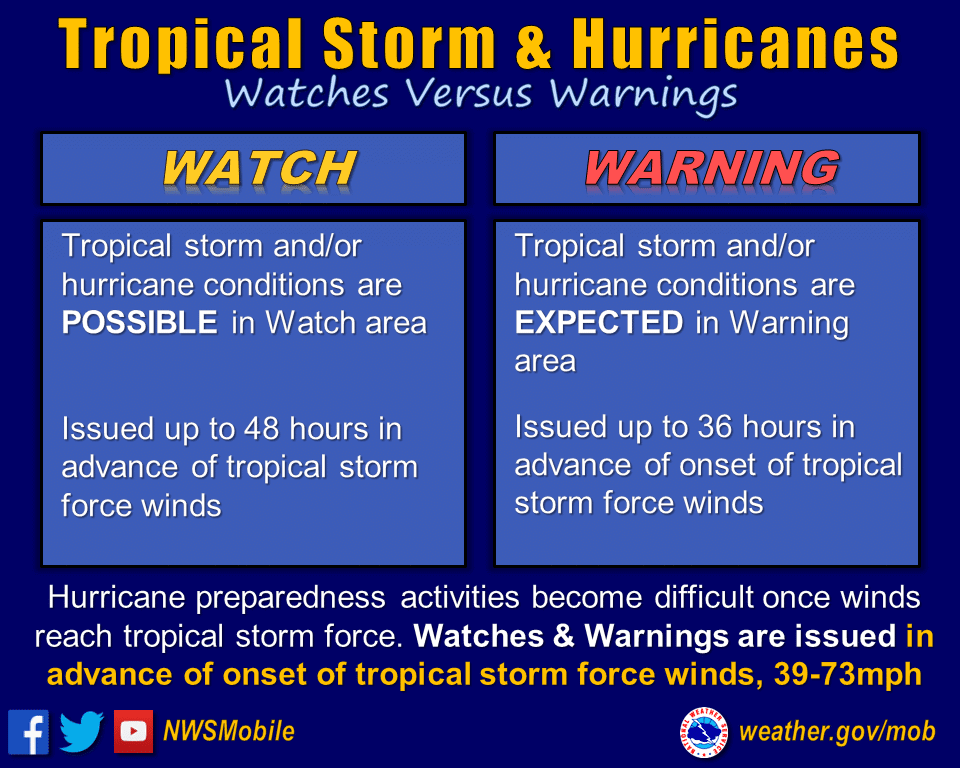In this post:
If you live on or near the coast and are under a hurricane watch or warning, it can be stressful. However, if you follow some basic guidelines, you can rest assured that you’ll be as safe as possible when the storm hits.

Hurricane Watch vs. Warning graphic from the National Weather Service
👉 Related reading: How Does Weather Radar Work? Doppler Radar Explained
Hurricane Watch
A hurricane watch is issued when hurricane conditions (sustained winds of 74 mph or higher) are possible within the specified area. As a general rule, the National Hurricane Center will issue a watch about 48 hours before tropical storm force winds (sustained winds of 39 to 73 mph) are expected. Why? It's to give those in the affected area sufficient time to prepare. When tropical storm force winds hit, it may not be safe enough to make any final preparations.
What to Do in a Hurricane Watch:
- Rush all preparations to completion. Move all loose objects inside so that they do not become airborne in high winds. Tape and board up all windows, and if you live in a storm surge-prone area and your house is at ground level take this time to move furniture and essentials to higher floors if possible to protect them from flooding.
- Prepare to evacuate if told to. Typically emergency managers will not order mandatory evacuations immediately after a hurricane watch is issued, but if you are located in an evacuation zone—especially a highly-populated area—it’s likely that you may be asked to evacuate quite soon. Review your evacuation plans. In fact, you should have a plan already in place before any storm hits.
- Monitor TV, radio, and weather radio reports. Look for official sources of information. Do NOT make decisions based on what you hear second-hand or through unofficial social media posts. Official forecasts are provided by both the National Hurricane Center and the National Weather Service.
- Have your emergency kit and supplies ready. This should include essential documents, medications, cash, clothes, non-perishable food, water, and a battery-powered emergency radio at a minimum (we’ve also written an entire post on severe weather emergency kits, it’s worth a read). Remember, after the storm hits, you may be cut off from essential services for days. It's best to be stocked up with supplies and equipped with a plan well before a watch is issued.
👉 Related reading: What Is the Best Barometric Pressure for Fishing?
Hurricane Warning
A hurricane warning is issued when hurricane conditions (sustained winds of 74 mph or higher) are expected within the specified area. NHC forecasters try to issue these warnings 36 hours before tropical storm force winds are expected to arrive. Pay close attention to all warnings and evacuation orders.
What to Do in a Hurricane Warning:
- Follow evacuation orders from local officials, if given. If you’re under mandatory evacuation orders, do not stay. Prepare your house for the storm, grab your emergency kit, and leave immediately. For those inside voluntary evacuation areas, you may choose to stay, but you could become cut off from essential services and be stuck if you do. We’d recommend evacuating outside of the evacuation zones if you can.
- Preparations should be completed. Often in hurricane warned areas, the outer bands—often quite strong themselves—will begin to affect the area well ahead of the storm. This will make any unfinished preparations difficult if not impossible to complete.
- Keep your emergency kit with you. At this point, you’ll want to keep your emergency kit with you at all times. You’ll have time to check it to ensure you have everything you need, but remember if you’re missing items like food and water, these might be too difficult to get at this point.
- Continuously monitor local media and forecasts. Official sources will have the latest information, and it’s a good idea to monitor these sources continuously. We strongly recommend purchasing an NOAA weather or emergency radio to include in your kit.
- During a hurricane (if NOT ordered to evacuate): stay put, stay inside and stay away from windows. Once the storm starts, do not leave your shelter. Take cover in an interior room, closet or hallway on the lowest level away from any windows. Put as many walls between you and the outside as you can. Do not go outside, as there may be flying debris in the area. If the eye of the storm passes over your area, there will be a short period of calm, but at the other side of the eye, the wind speed rapidly increases to hurricane force winds and will come from the opposite direction. Only leave shelter when instructed to by authorities.

Hurricane Irma track graphic from the NOAA National Hurricane Center
Continue reading:





